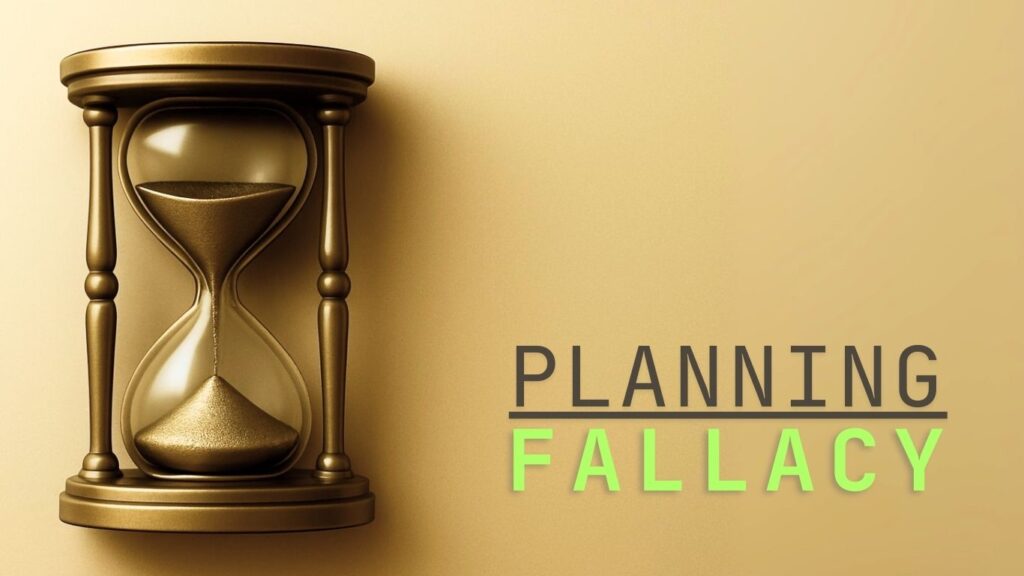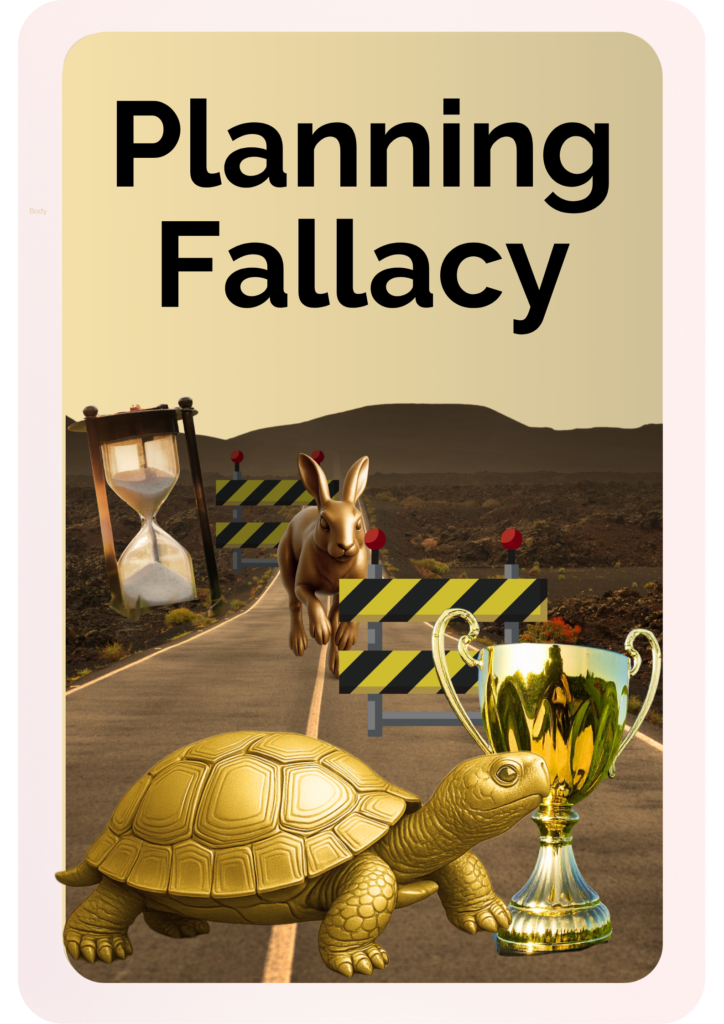Win at Life

What it is – and why it’s useful
The Planning Fallacy is the very human tendency to underestimate how long tasks will take, even when we’ve done them before and should know better.
Psychologists Daniel Kahneman and Amos Tversky first studied it back in 1979, after noticing that people consistently predicted shorter timescales for projects than they were actually able to achieve.
Once you notice it, you see it everywhere. From daily chores to major projects, even the most pessimistic among us tend to assume the best case, gloss over delays, and forget that things running perfectly to plan is the exception, not the rule.
The result is that we can end up stressed, late, or frustrated with ourselves. “I’m so rubbish, I can never finish things on time.” We tell ourselves we’re inefficient, lazy, or easily distracted, when in truth the problem is baked into how our brains work.
Seeing the Planning Fallacy for what it is can be oddly reassuring. It isn’t that you are hopeless at organising yourself, it’s that your mind is wired to lean towards optimism.
Anticipating how you’ll handle life’s inevitable time-gobbling fiascos doesn’t mean you’re inviting them in, it just makes you far more likely to meet your deadlines.
Real-life examples
- You think you’ll “just quickly” tidy the kitchen before heading out. Forty minutes later, a series of unfortunate (but eminently avoidable) events mean you are on your knees with defrosting the freezer with a hairdryer.
- At work, you confidently estimate a proposal will take two weeks. A month later, you’re still knee-deep in revisions, debating ‘which shade of blue looks more trustworthy’, and wondering how the “quick draft” turned into your Magnum Opus.
- You promise a friend you’ll be ready to leave in ten minutes. They give a weary raised eyebrow and put the kettle on, knowing your You-ten minutes will involve trying on five outfits before wearing the first one, and another five crawling around hunting for your false eyelashes you insist on if you’re going OUT out.
- You have an hour to send across a report, but spend the first 40 minutes willing a Windows update stuck on 27% to move to 28%, cursing your computer and your general life choices.
- You plan a little Saturday morning DIY job. By late Sunday evening you’re scribbling a note to self: “must factor in masking, priming, sanding, washing the roller, going back to B&Q for paint thinner, and painting the ceiling which, unhelpfully, now looks brown“. You’ll finish it next weekend.
Try this today
When estimating time for a task, try doubling it as a default.
If you think something will take an hour, allow two. It might feel cautious, but one of two things will happen: you either finish early and enjoy the smug glow of being ahead of schedule, or you take the full buffer but without the stress of thinking you are behind.
Some things to think about
- Do you tend to imagine the best case scenario when you plan, rather than factoring in delays or interruptions?
- How often do you forget to include setup, admin, or “wrap-up” time in your estimates?
- What would change if you treated time like money: always keeping a buffer, never spending to the last penny?
- How different would your days feel if deadlines were realistic, not just optimistic guesses?
- Where might you be underestimating time right now, and what would a more generous allowance do for your peace of mind?
Optional Challenge
For the next week, keep a simple log of your time estimates: vs actual time taken.
Pick three tasks each day, jot down how long you think they’ll take, then compare with what really happened. By the end of the week you’ll have your own personal time bias gap mapped out.
With that intel, you can start to plan more honestly and enjoy the security of knowing you’re no longer at the mercy of your brain’s wishful thinking sales pitches.
“Do not be reckless with time. A fool is restless, always hurrying, but the wise live calmly, knowing that things take time.” – Dhammapada
Rushing rarely makes things quicker. Most of the stress comes from believing we should have been finished already. The tortoise didn’t win by sprinting or by pretending the race would be over in half the time. Building in contingency-proofing might not sound sexy, but it’s often the strongest way to reach the finish line, without the panic and without losing yourself along the way.
Back to Mindset Mechanics <
Back to The Vault <
References
- Kahneman, D., & Tversky, A. (1979). Intuitive prediction: Biases and corrective procedures. TIMS Studies in Management Science, 12, 313–327.
- Kahneman, D. (2011). Thinking, fast and slow. London: Penguin Books.

